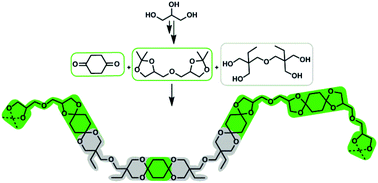当前位置:
X-MOL 学术
›
Polym. Chem.
›
论文详情
Our official English website, www.x-mol.net, welcomes your feedback! (Note: you will need to create a separate account there.)
Polycycloacetals via polytransacetalization of diglycerol bisacetonide†
Polymer Chemistry ( IF 4.6 ) Pub Date : 2018-08-27 00:00:00 , DOI: 10.1039/c8py01191e Andrea Hufendiek 1, 2, 3, 4, 5 , Sophie Lingier 1, 2, 3, 4, 5 , Pieter Espeel 1, 2, 3, 4, 5 , Stefaan De Wildeman 6, 7, 8, 9, 10 , Filip E. Du Prez 1, 2, 3, 4, 5
Polymer Chemistry ( IF 4.6 ) Pub Date : 2018-08-27 00:00:00 , DOI: 10.1039/c8py01191e Andrea Hufendiek 1, 2, 3, 4, 5 , Sophie Lingier 1, 2, 3, 4, 5 , Pieter Espeel 1, 2, 3, 4, 5 , Stefaan De Wildeman 6, 7, 8, 9, 10 , Filip E. Du Prez 1, 2, 3, 4, 5
Affiliation

|
Diglycerol bisacetonide was synthesized and isolated from acetone and diglycerol, which is renewable and available in large scale. DGA was directly used in polytransacetalization with 1,4-cyclohexanedione or 4,4′-bicyclohexanone as diketone monomers. Polycycloacetals were obtained with molecular weights (Mn) of up to 28 kg mol−1, broad dispersities (Đ = 1.5–4.0) and as semi-crystalline polymers with high melting points (Tm = 210–241 °C) and glass transition temperatures (Tg) of 48 °C or 65 °C. Introducing di(trimethylolpropane) (di-TMP) in the polymerization of DGA and 1,4-cyclohexanedione resulted in copolymers as confirmed by 1H-NMR and 13C-NMR spectroscopy. Increasing the di-TMP content from 10 to 50 mol% reduces the crystallinity of the polycycloacetals and increases the Tg, eventually yielding amorphous polymers (Tg = 60–71 °C). For the amorphous polycycloacetals, Young's moduli could be determined by tensile strength testing (E = 1.1–1.4 GPa). The polycycloacetals with renewable carbon contents in the range of 33–100% cover a wide range in material properties and are stable against hydrolysis at pH > 1–3, depending on the polycycloacetal composition.
中文翻译:

通过甘油二丙酮双缩醛缩聚反应制得的聚 环缩醛†
从丙酮和双甘油中合成并分离出双甘油双丙酮化物,它们是可再生的并且可大规模使用。DGA直接用于1,4-环己二酮或4,4'-双环己酮作为二酮单体的聚反缩醛化反应中。获得的多环缩醛的分子量(M n)高达28 kg mol -1,分散性广(Đ = 1.5–4.0),并且是具有高熔点(T m = 210–241°C)的半结晶聚合物和玻璃转变温度(T g)为48°C或65°C。通过1 H-NMR和1 H-NMR证实,在DGA和1,4-环己二酮的聚合反应中引入二(三羟甲基丙烷)(di-TMP)得到共聚物。13 C-NMR光谱。将di-TMP含量从10 mol%增加到50%会降低多环缩醛的结晶度并增加T g,最终生成无定形聚合物( T g = 60–71°C)。对于无定形聚环缩醛,可以通过拉伸强度测试( E = 1.1–1.4 GPa)确定杨氏模量。可再生碳含量在33-100%范围内的聚环缩醛涵盖了广泛的材料性能,并且在pH> 1-3的条件下对水解稳定,具体取决于聚环缩醛的组成。
更新日期:2018-08-27
中文翻译:

通过甘油二丙酮双缩醛缩聚反应制得的聚 环缩醛†
从丙酮和双甘油中合成并分离出双甘油双丙酮化物,它们是可再生的并且可大规模使用。DGA直接用于1,4-环己二酮或4,4'-双环己酮作为二酮单体的聚反缩醛化反应中。获得的多环缩醛的分子量(M n)高达28 kg mol -1,分散性广(Đ = 1.5–4.0),并且是具有高熔点(T m = 210–241°C)的半结晶聚合物和玻璃转变温度(T g)为48°C或65°C。通过1 H-NMR和1 H-NMR证实,在DGA和1,4-环己二酮的聚合反应中引入二(三羟甲基丙烷)(di-TMP)得到共聚物。13 C-NMR光谱。将di-TMP含量从10 mol%增加到50%会降低多环缩醛的结晶度并增加T g,最终生成无定形聚合物( T g = 60–71°C)。对于无定形聚环缩醛,可以通过拉伸强度测试( E = 1.1–1.4 GPa)确定杨氏模量。可再生碳含量在33-100%范围内的聚环缩醛涵盖了广泛的材料性能,并且在pH> 1-3的条件下对水解稳定,具体取决于聚环缩醛的组成。


























 京公网安备 11010802027423号
京公网安备 11010802027423号